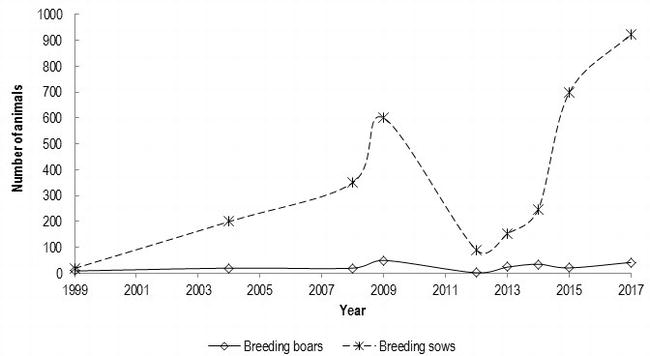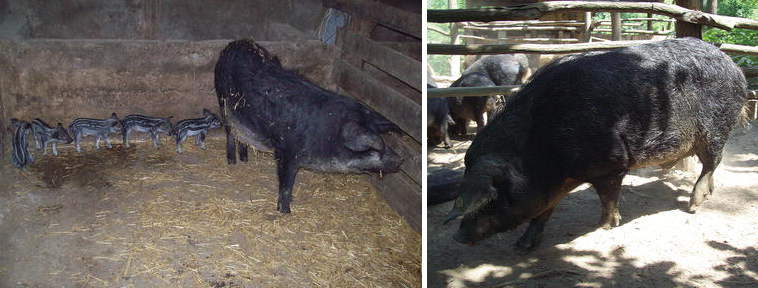History and current status of the breed
Mangalitsa is an autochthonous fatty type pig breed, created from the old Serbian Šumadinka breed. During the nineteenth century, pigs were the main export product of Serbia, especially in the northern part of the country (today’s Autonomous Province of Vojvodina) and in the region of Šumadija (central part of Serbia). In Šumadija, pigs were mostly fattened in the forests where they were searching for oak and beech acorn and other forest feed resources. The majority of animals were exported to the former Austro-Hungarian monarchy. In that time, the pig farming was based on local indigenous breeds with the dominant breeds Šiška and Šumadinka. Šiška and Šumadinka were the most primitive breed of pigs, created by domestication of wild pigs Sus scrofa ferus. Šiška once had high importance, in the relatively recent past (eighteenth century), not only in Serbia but also in Croatia, Slovenia, Hungary, Romania and Bulgaria. In the nineteenth century, a new breed Šumadinka was created by domestication of wild pigs (Sus scrofa ferus) and reared in slightly better conditions. Both of these breeds are lost in their original form. However, Šumadinka can be considered as an important ancestor of Mangalitsa. In the Republic of Serbia, there are three Mangalitsa breed types: swallow-belly strain (Srem black Mangalitsa or Buđanovci pig developed in the area of Srem near Ruma, a village of Buđanovci), white strain (blonde or Hungarian strain, created when in 1833 Prince Miloš Obrenović gave two boars and 10 sows of Šumadinka breed to the Hungarian nobleman Palatine Joseph on the farm Kisjeno where better rearing conditions, accommodation and food source were provided, which lead to the creation of more productive pig breed of white Mangalitsa) and red strain (mainly represented on the territory of Hungary and Romania and, in our country, present only in traces).

Apart from Serbia, the Mangalitsa is present in Austria, the Czech Republic, Germany, Romania, Hungary, Slovakia and Switzerland. Chronological population dynamics of Mangalitsa pig breed is presented in Figure 1. In 2016, only on the territory of Central Serbia, 321 sows and 32 boars were registered (in the records of the Main Breeding Organization). At the end of 2017, on the territory of R. Serbia, there were about 67 registered farms with 925 sows, 605 gilts and 42 boars registered in the records of the Main Breeding Organization, of which more than 95% are swallow-belly strain.


Exterior characteristics
The main morphological characteristics of the Mangalitsa breed are summarized in Table 1. It is a medium-size breed, known for its thick, wooly coat similar to that of a sheep. The three Mangalica breed types are blonde, swallow-belly and red Mangalitsa. Swallow-belly strain (Figure 2), which is one of the most numerous in Serbia, is late maturing type, resistant and well adapted to extensive rearing and housing conditions. It requires only a simple shelter from rain and snow. The head is relatively small, with large ears that hang in front over the eyes and face. The earlobe is set high and elastic to the touch. The ear length is 2/3 of the length of the head. The chest and short torso/body are broad and deep and extend to just below the elbow. The back and loin are straight or slightly curved from the side view. The back part of the body and thighs are well developed, wide and muscular. The abdomen is long and cylindrical with the mammary complex consisting of four to six pairs of teats. Limbs are long, wide and muscular. The skin is pigmented, dark or brown in colour, with dense, bright and curly bristles that are shorter in swallow-belly strain. The colour of bristles can be from grey-yellow to reddish (ginger). The eyelids, eyebrows, muzzle, nipples of the mammary complexes, hooves, tail tip and natural openings on the body are always black. Brinzej states that there are two varieties of this type, of which one from the western breeding region is called “Buđanovac” variety named after the village Buđanovci. This variety has a greater part of the body pigmented (entire head, body and the sides of the body and the legs from the outer-lateral side to the claws). The second variety—“Otok” and “Lasa” named after the village of Otok in the western part of the Srem region—with the legs pigmented only to the hock joint and the lower part of the papilla is white. The Otok variety has regularly strongly developed bristles, which the “Buđanovac” variety lacks or is less developed. At birth, piglets have characteristic stripes, which disappear in 10 days in white strain piglets and in 3–4 months in swallow-belly strain.
Table 1. Summary of the main morphological characteristics of the Mangalitsa breed.
| Measurement (average) | Adult male | Adult female |
|---|---|---|
| Body weight (kg) | 78 | 73 |
| Body length1(cm) | 95 | 92 |
| Height at withers (cm) | 78 | 78 |
| Number of teats (average) | - | 8-12 |
1Measured from the tip of the nose to the starting point of the tail.
Geographical location and production system
Mangalitsa pigs are reared in the wider area of the Republic of Serbia, mostly along major waterways. Farms are located in the municipalities of Subotica, Sremska Mitrovica, Bačka Palanka, Vršac, Pančevo, Ub, Obrenovac, Ljig, Valjevo, Novi Sad, Kuzmin, Šid, Surčin and Kovilj (Krčedinska ada). Some Mangalica pigs can also be found on Stara Planina mountain (Municipality of Dimitrovgrad) and around Čačak and Kraljevo.
These pigs are usually reared in free-range conditions, outdoor, extensive or in semi-intensive production systems. Rearing of pigs implies a free holding in limited areas in pastures, woods or orchards. In extensive system, pigs are kept around the household, which depends on the number of animals and size of the owner’s property, and in the winter period, animals are housed in cheap, wooden pig stables. Feeding them is primarily based on pasture and forest products (oaks, wild fruits). Additional daily meal represents an extremely small amount of grains per head, primarily corn. In extensive system sows very frequently farrow in the forest, which significantly complicates the control of productivity and recording. In semi-intensive conditions, sows are farrowed in objects, which allows for better control. In the growing and fattening phase, pigs are mostly outdoor.
Productive performance
Reproductive traits
The age of Mangalitsa pig breed sows at the first parturition is approximately 17.3 months. They have 1.2–2.0 litters per year with around five piglets of 1.1–1.6 kg live body weight. Stillborn percentage of piglets ranges from only 2.2 to 7.5%, whereas piglet mortality rate until weaning in the considered studies varies from 2.0 to 11.1%. Duration of lactation is prolonged in comparison to modern intensive systems to 50 days on average (ranging from 37 to 60 days, which leads to a longer farrowing interval (around 216 days on average and higher weaning weight.
Growth performance

Due to big differences between studies with regard to the live weight range covered, we defined the stages for growth performance as lactation (regardless of how long it was), growing stage (from weaning to approximately 30 kg live body weight) and early, middle and late fattening stages estimated between approximately 30 and 60 kg, 60 and 100 kg and above 100 kg live body weight, respectively. In the considered studies, the daily gain in the early growing stage that corresponds to lactation period was approximately 136 g/day. The average daily gain in growing stage was 310 g/day; 430, 519 and 405 g/day in early, middle and late fattening stage; 434 g/day in overall fattening stage; and 307 g/dayfrom birth to slaughter. In the context of the evaluation of growth performance, it is also of interest to observe the extreme values, because it can be assumed that the maximum figures exhibit the growth potentials of Mangalitsa pigs in ad libitum conditions of feeding (≈830 g/day in overall fattening stage).
Body composition and carcass traits
In the considered studies, pigs of the Mangalitsa breed were slaughtered at approximately 114 kg live weight. Dressing yield ranged from 73 to 80% and lean meat content 28 to 37% (SEUROP classification or dissection). The backfat thickness values measured at the level of the last rib span from 42 to 81 mm, at the position of withers from 59 to 102 mm and at the level of gluteus medius muscle from 48 to 79 mm (n = 8). Muscularity measured as loin eye area was 24 cm2 and as muscle thickness measured from the vertebral canal to the cranial edge of gluteus medius muscle around 60 mm.
Meat quality
In the studies reporting meat quality of Mangalitsa pigs, pH measured in longissimus muscle at 45 minutes and 24 hours post-mortem was around 6.1 and 5.6, respectively. The intramuscular fat content is very high in reported studies and ranges from 2.9 to 18.2%. The colour measured in CIE L, a, b colour space was approximately 45, 11.4 and 4.2 for L, a* and b*, indicating relatively dark colour of Mangalitsa. In the considered studies, SFA, MUFA and PUFA contents of intramuscular fat in the longissimus muscle were in around 35, 56 and 7%, respectively, with high n6 to n3 ratio.
Use of breed and main products
Mangalitsa is a late maturing pig breed, selected for fat production. It has low fertility, long suckling period and a very weak-slow growth. But on the other hand, Mangalitsa is very resistant and well adapted to extensive conditions of housing, where the needs are only for a simple shelter from rain and snow. With such features, its cost-effectiveness is in low investment in housing facilities with large areas for pasturing and acorn nutrition, preferably if an organic breeding system is possible. Considering the low production performance (low daily gain and meatiness), crossbreeding with the Moravka, Resavka, Duroc, Hampshire or Berkshire breed could contribute to an improvement of growth and carcass traits, with the shorter fattening period and higher percentage of meat content in the carcass. The animals not chosen for the nucleus herd could be crossed with Duroc, Hampshire or Berkshire which would contribute to more economical production of meat and the production of traditional high-value products (ham, sremski kulen and Sremska sausages) and their marketing as highly valuable organic products or products protected by a geographical indication.
Dry-fermented sausages are meat products with a very long tradition of production, and today there are numerous national variants of these products. The most popular types of traditional fermented sausages in Serbia are kulen and Sremska sausage. Kulen, a traditional fermented dry sausage, is a well-known and very popular meat product in the north of Serbia (Srem, Bačka) and Croatia (Slavonia, Baranja). remska sausage is a Serbian dry-fermented sausage traditionally produced in the north-western part of Serbia (Srem region).
Full text and references are available here: Mangalitsa (Swallow-Belly Mangalitsa) Pig
Čedomir Radović, Radomir Savić, Milica Petrović, Marija Gogić, Miloš Lukić, Dragan Radojković and Nina Batorek-Lukač (February 6th 2019). Mangalitsa (Swallow-Belly Mangalitsa) Pig, European Local Pig Breeds - Diversity and Performance. A study of project TREASURE, Marjeta Candek-Potokar and Rosa M. Nieto Linan, IntechOpen, DOI: 10.5772/intechopen.83773. Available from: https://www.intechopen.com/books/european-local-pig-breeds-diversity-and-performance-a-study-of-project-treasure/mangalitsa-swallow-belly-mangalitsa-pig



